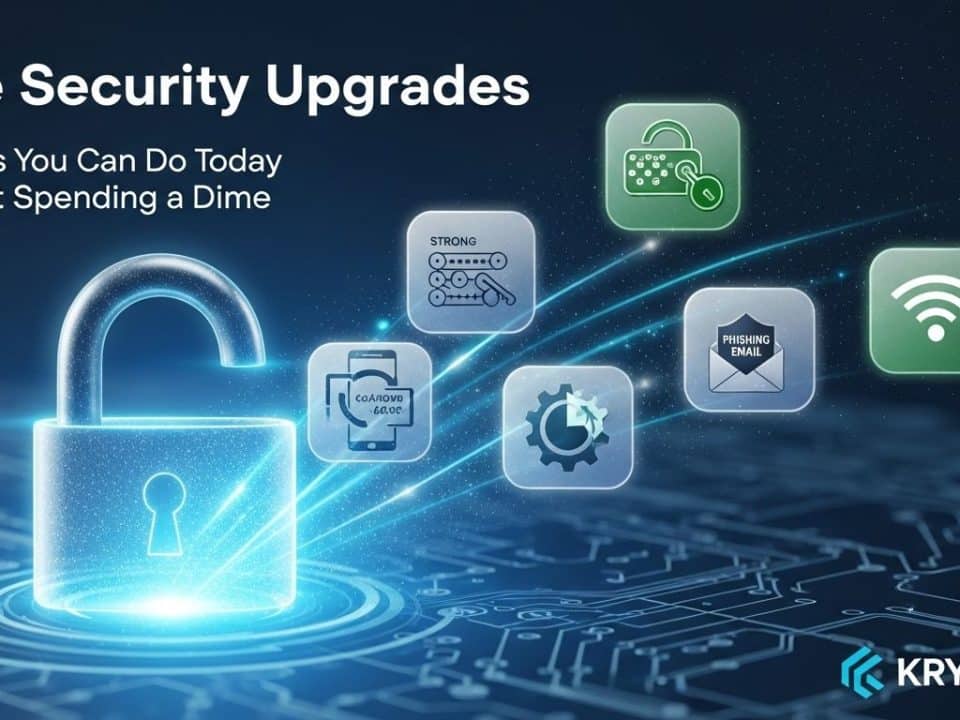
Protecting Your POS: Basic Security for Retail and Hospitality
November 14, 2025By the Team at Krypto IT | Cybersecurity Experts Serving Houston SMBs
For all the talk about complex ransomware attacks and sophisticated network intrusions, the entry point for the vast majority of all successful cybercrimes against small to medium-sized businesses (SMBs) is simple: email.
Your email inbox is the single most exposed, most actively targeted asset in your digital environment. Phishing scams, Business Email Compromise (BEC), and account takeovers are relentless, and they cost businesses billions annually. Why? Because it’s exponentially easier to trick an employee into clicking a bad link than it is to breach a secure firewall.
At Krypto IT in Houston, we know that securing your business starts with securing your inbox. This guide breaks down the two most dangerous email threats and provides the essential, non-negotiable steps you must take to protect your employees and your bottom line.
1. Phishing: The High-Volume Bait
Phishing is a social engineering attack where a criminal sends a deceptive email designed to steal sensitive information (like passwords) or deploy malware. Phishing attacks succeed because they leverage urgency, fear, or curiosity.
The Modern Threat: AI and Spear Phishing
The days of easily spotted, grammatically incorrect phishing emails are over. Today, criminals use AI to generate flawless, highly personalized messages that mimic real colleagues or vendors. This is spear phishing, where the attacker targets a specific individual with information relevant to their job, making the scam highly believable.
The Phishing Goal
- Credential Theft: The email directs the user to a fake login page (e.g., a perfect replica of the Microsoft 365 login screen). The user enters their credentials, handing the keys to the kingdom directly to the attacker.
- Malware Delivery: The email contains a malicious attachment (often disguised as an invoice or a document scan) that, when opened, installs ransomware or a trojan on the system.
2. Business Email Compromise (BEC): The Money Transfer Scam
BEC is often the most financially devastating email attack. This is a targeted scam where the criminal impersonates a trusted authority—usually the CEO, CFO, or a high-level vendor—to trick an employee into transferring funds or releasing sensitive data.
How a BEC Attack Works
- Account Takeover: The criminal first steals the credentials of a senior executive (via a phishing attack or weak password).
- Impersonation: The criminal then sends an email from the legitimate executive’s email address (or one that looks almost identical: ceo@krypt0-it.com instead of ceo@krypto-it.com).
- The Fraud: The email urgently instructs the accounting or finance department to initiate a wire transfer to a “new vendor” or “urgent acquisition,” often citing confidentiality and demanding immediate action. The amount requested can be tens of thousands of dollars.
The Result: The money is transferred willingly by the employee and is almost impossible to recover, making BEC one of the costliest threats facing SMBs.
The Non-Negotiable Defense Strategy
Stopping email-based attacks requires a layered defense that integrates technology with human awareness.
1. Mandatory Multi-Factor Authentication (MFA)
MFA is your single most important defense against phishing and BEC. If an employee clicks a fake login page and gives away their password, MFA ensures the hacker is still stopped at the second verification step (the code on the employee’s phone). Krypto IT mandates MFA deployment across all email, cloud services, and VPN access.
2. Advanced Email Filtering and Protection
Your free or basic spam filter is insufficient for modern AI-generated attacks. You need professional, enterprise-grade filtering that performs:
- Link Analysis: Scanning links in real-time to see if they lead to known malicious sites.
- Domain Impersonation Protection: Detecting subtle differences in sender addresses (e.g., catching that extra ‘0’ in the domain name) before the email lands in the inbox.
- Tone Analysis: Flagging unusual tone or urgent requests that deviate from normal sender behavior.
3. Implement a Zero Trust Verification Process
To stop BEC, you must eliminate blind trust in email.
- Verbal Confirmation: Any request for a wire transfer or sensitive data release (HR files, client lists) must be verified via a second, non-email channel—ideally a phone call to a known, trusted number (not the number provided in the suspicious email).
- Training on Financial Controls: Finance and HR teams must be rigorously trained to spot red flags: urgent, unexpected, or confidential payment requests.
4. Continuous Security Awareness Training (SAT)
Your employees are your weakest link until you train them to be your strongest defense. SAT must be mandatory, ongoing, and realistic.
- Phishing Simulations: Krypto IT runs regular, realistic phishing tests. Employees who click the link receive immediate, targeted micro-training, turning a mistake into a learning opportunity.
- Focus on Behavior: Training should teach employees to pause, check the sender’s full email address, and verify unusual requests rather than simply relying on visual cues.
Don’t Let Your Inbox Become a Liability
For SMBs, a successful email attack can lead to financial devastation, data exposure, and crippling downtime. The threat is constant and sophisticated, but the solution—layered defense, technology enforcement, and continuous training—is manageable with the right partner.
Krypto IT provides the tools and expertise to secure your email environment, manage advanced filtering, and transform your workforce into a vigilant human firewall.
Ready to stop phishing and BEC cold? Contact Krypto IT today for a complimentary email security assessment.




